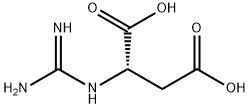- GUANIDINOSUCCINIC ACID
-

- $15.00 / 1KG
-
2021-07-02
- CAS:6133-30-8
- Min. Order: 1KG
- Purity: 99%+ HPLC
- Supply Ability: Monthly supply of 1 ton
|
| | GUANIDINOSUCCINIC ACID Basic information |
| Product Name: | GUANIDINOSUCCINIC ACID | | Synonyms: | (2S)-2-(diaminomethylideneamino)butanedioic acid;L-ASPARTICACID,N-(AMINOIMINOMETHYL)-;2-Guanidinosuccinic acid;(S)-GUANIDINOSUCCINIC ACID;guanidinosuccic acid;(S)-GUANIDINOSUCCINIC ACID dihydrobromide;GUANIDINOSUCCINIC ACID;N-AMIDINO-L-ASPARTIC ACID | | CAS: | 6133-30-8 | | MF: | C5H9N3O4 | | MW: | 175.14 | | EINECS: | | | Product Categories: | amino acids | | Mol File: | 6133-30-8.mol |  |
| | GUANIDINOSUCCINIC ACID Chemical Properties |
| Boiling point | 344.5±52.0 °C(Predicted) | | density | 1.74±0.1 g/cm3(Predicted) | | storage temp. | 2-8°C | | solubility | DMSO: 1 mg/ml; PBS (pH 7.2): 5 mg/ml | | form | A solid | | pka | 3.22±0.23(Predicted) | | color | White to off-white |
| WGK Germany | 3 | | RTECS | CI9098875 |
| | GUANIDINOSUCCINIC ACID Usage And Synthesis |
| Uses | Guanidinosuccinic acid is a nitrogenous metabolite. | | Definition | ChEBI: An aspartic acid derivative comprising L-aspartic acid carrying an N-amidino substituent. | | in vivo | Guanidinosuccinic acid, a constituent of normal urine, is elevated in the urine and serum of azotemic patients[1]. Guanidinosuccinic acid (GSA), a guanidino compound found to be greatly increased in uremia, is administered by intraperitoneal (i.p.) injection to adult albino mice and to young mice 7, 14 and 21 days old. Epileptogenic and toxic properties are assessed and Guanidinosuccinic acid brain levels following i.p. injection ae determined. In adult mice, Guanidinosuccinic acid induces long-lasting generalized clonic and clonic-tonic convulsions in a dose-dependent manner with a CD50 (and 95% confidence interval) of 363 (287-458) mg/kg (n=35), and an LD50 of 579 (445-756) mg/kg. The CD50 of Guanidinosuccinic acid corresponded with a brain concentration of 56 nmol/g tissue. Electrocorticographic recording in five adult mice revealed epileptiform discharges (spikes, spike-waves, and polyspike-waves) which appeared concomitant with the convulsions, When young mice are i.p. injected with a (for adults) subconvulsive dose of Guanidinosuccinic acid (250 mg/kg), an age-dependent decrease is noted in Guanidinosuccinic acid-induced convulsions and in the resulting brain concentration[2]. | | IC 50 | Human Endogenous Metabolite | | References | [1] Milstien S, et al. Role of intestinal microflora in the metabolism of guanidinosuccinic acid. J Bacteriol. 1973 May;114(2):641-4. DOI:10.1128/jb.114.2.641-644.1973
[2] D'Hooge R, et al. Behavioral toxicity of guanidinosuccinic acid in adult and young mice. Toxicol Lett. 1992 Dec;64-65 Spec No:773-7. DOI:10.1016/0378-4274(92)90261-h |
| | GUANIDINOSUCCINIC ACID Preparation Products And Raw materials |
|